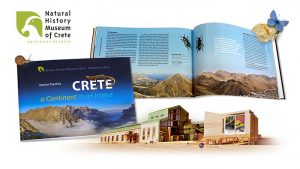
The Natural History Museum (University of Crete) has recently released the long-awaited book on the nature of Crete, entitled «Crete, a continent in an island» translated by Ben Petre. This publication is an essay by Dimos Tsantilis, a writer and communicator of science, in cooperation with scientists working at the museum, containing more than 350 color photographs (and drawings).
In 280 pages, the author presents the complex geological history of Crete, its past and modern geodiversity, the plants, the animals and the ecosystems of the island, and the role of the long-term impact of its inhabitants. The numerous and high quality illustrations provide a unique visual experience for the enthusiasts of the Cretan nature, but also a material valuable to both amateur naturalists and professionals.
The aforementioned issues are extensively developed in 21 chapters. In the first four the author covers the geological history of the island, the evolution and establishment of the Mediterranean climate over past geological periods as well as the current effect of various factors, such as precipitation on the formation of the modern Cretan landscape.
More details on the fossil record of plants and animals of Crete are given in the next three chaptes, emphasizing its chronology and importance.
The chapter «Mediterranean adaptations» attempts to present the Cretan flora, pointing out its richness and emphasizing its unique character. The effect of water deficiency, wildfires etc. are also discussed here, while the next two chapters are devoted to forest diversity and the endemic plants of Crete.
Six chapters are devoted to vertebrates (mammals, reptiles, amphibians and birds), and three chapters, to the invertebrate biodiversity of Crete, not commonly seen in the literature. Three chapters are dedicated to the terrestrial arthropods and land snails of the island, including information on their ecology, evolution and endemism.
The next four chapters are related to the special features of the Cretan landscape that deserve special attention: satellite islets, beaches, mountain tops and the numerous caves and karst formations of the island.
The last chapter concludes the tour into Cretan nature, bringing the readers to the position of someone who interacts with and modifies their environment in an attempt to raise concerns, but also to inspire solutions aiming at the harmonious coexistence of humans and nature.
